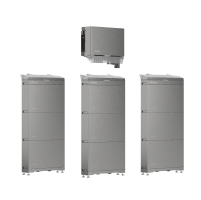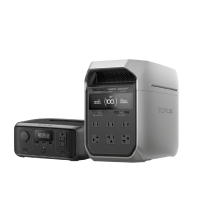What's the Difference Between MPPT and PWM Controllers?
During 2023, there were a record number of solar panel systems installed on homes in the UK due to the huge cost savings on offer. Able to harness the abundant energy from the sun, home solar systems help to lower electricity bills and minimise a property’s carbon footprint and one of the key components that make this possible is the charge controller. There are two types available when investing in a solar setup: MPPT or PWM.
Understanding the difference between MPPT and PWM is vital when determining which is the right option for your property, and that’s the focus of this blog. Here, we take a detailed look at the characteristics of each, shining a light on their pros and cons.
What kind of product or solution are you interested in?


PWM vs MPPT? Let’s First Look at the Basics
Before we start looking at whether to choose an MPPT or PWM solar controller, we’ll first look at what the basic job of the component is. Like many of the components inside hardware like the PowerOcean homebattery system, the solar controller is essential to the operation of the entire setup. Basically, their main job is to safely regulate the current as it moves from the solar panels to the batteries.
Another of their primary functions is to ensure that the battery is charged efficiently while also preventing overcharging and deep discharging (where the battery is drained too much). Either of these outcomes can damage the battery and reduce its lifespan.
MPPT and PWM charge controllers constantly monitor the battery's charge state and adjust the energy flow accordingly, protecting its integrity and optimising its performance. That said, it’s important to know exactly how each type works, so let’s look at each one in isolation.
What is an MPPT Controller?
Maximum Power Point Tracking technology - or MPPT for short - is sophisticated hardware that optimises the power output of your system’s solar panels. When in operation, they continuously monitor the current and voltage coming from the panels, ensuring that they’re always working at the optimal level. Naturally, the intensity of available sunlight is going to vary, but with an MPPT charger in place, you can always be sure you're not wasting a second of it.
When comparing PWM vs MPPT controllers, the latter offers the following benefits:
- They can improve the efficiency of your home's solar setup by up to 30%, ensuring that more energy is harvested and used.
- They perform better when the weather varies, meaning they're a popular choice in the UK, where the climate is changeable from day to day.
- This type of solar charger is particularly suitable for larger home setups, as any extra efficiency is going to be amplified.
This is the more expensive of the two options, initially at least. However, it's able to squeeze every drop of energy out of your solar panels, meaning the cost is quickly recouped.
What is a PWM Controller?
So, what is the difference between MPPT and PWM controllers? PWM stands for Pulse Width Modulation, which describes a simple method of voltage and current regulation - again, from the solar panels to the batteries. However, the difference lies in how it works. As such, it slowly reduces the power supplied to the battery as it gets closer to being full.
If the flow of electricity didn't slow down as the battery neared its full capacity, there's a very good chance that overcharging would occur. While they might not be quite as efficient as MPPT controllers, they are very effective when in smaller solar setups where the conditions and energy demands are more stable.
The benefits of choosing PWM vs MPPT controllers include:
- Simple to install and use, making them ideal for basic solar setups
- They're typically cheaper than MPPT controllers, meaning they're perhaps the option of choice when your budget is tight.
- Despite being lower in cost, PWM controllers are extremely reliable in terms of performance.
It's worth reiterating here that PWM controllers don’t offer the same system optimization benefits and primarily act as a safety feature that prevents overcharging.
Choosing the Right Controller for Your Solar System
So, now that we've covered the fundamentals of solar charger technology, we now look at how to make a choice between MPPT or PWM equipment for your solar setup. When talking to an EcoFlow expert, you’ll typically take into account the following factors…
- The Amount of Energy Your Home Requires - Is your home a mid-sized abode with a solar system that produces over 200 watts per hour? If so (and most are), then an MPPT controller is likely to be the best option, as the optimisation it provides will save you money in the long run.
- The Size of Your Budget - The reality is that MPPT controllers cost more than their PWM counterparts, so they'll cost you more upfront. That said, the savings provided by MPPT hardware will usually be recouped over time, meaning it's the wisest option from a long-term cost-efficiency point of view.
- Environmental Conditions - In Britain, weather conditions can vary greatly, meaning it is not always sunny…far from it. As such, there are frequent cloud covered days and temperature fluctuations, which necessitate the use of MPPT technology. In warmer areas of the world where sunshine is more frequent, a PWM controller may suffice.
In a nutshell, the PWM vs MPPT quandary can be answered with a couple of simple questions. 1) Do you live somewhere where sunshine is pretty much guaranteed for most of the year? and 2) Does your home solar setup produce more than 200 watts per hour? The vast majority do, as just a 5kW system will averagely produce 800 watts per hour over the course of a year.
What that means is that, in most cases, UK homeowners are going to need a system that has an MPPT solar charger built into it. There's nowhere in England, Scotland, Ireland or Wales that can provide sufficiently consistent sunlight for a PWM charger to be the best option. The good news is that every EcoFlow home battery system comes with MPPT hardware as standard.
Let EcoFlow Find You the Perfect Home Battery System With the Ideal Solar Controller
While a solar controller might only be a small component within your home solar system, it’s just as important as any other major part. Finding the right option for your needs involves taking a range of factors into account - something the EcoFlow team is more than equipped to do.
In most cases, UK homes will require an MPPT controller. However, our experts will still go through a rigorous evaluation process with you to ensure that you get the perfect setup for your home and your energy needs. If you're interested in investing in your financial future and would like to become less reliant on the grid, why not take a look around our website Homebattery.ecoflow.com/uk?
Alternatively, if you would like to speak to a member of our team about anything discussed here, all you have to do is enter your details into our contact form and we’ll be in touch very soon.



